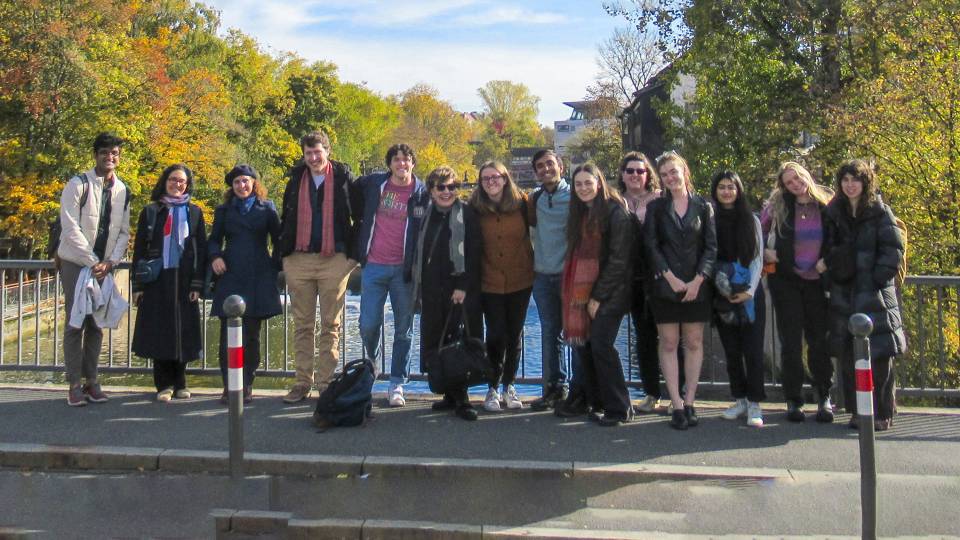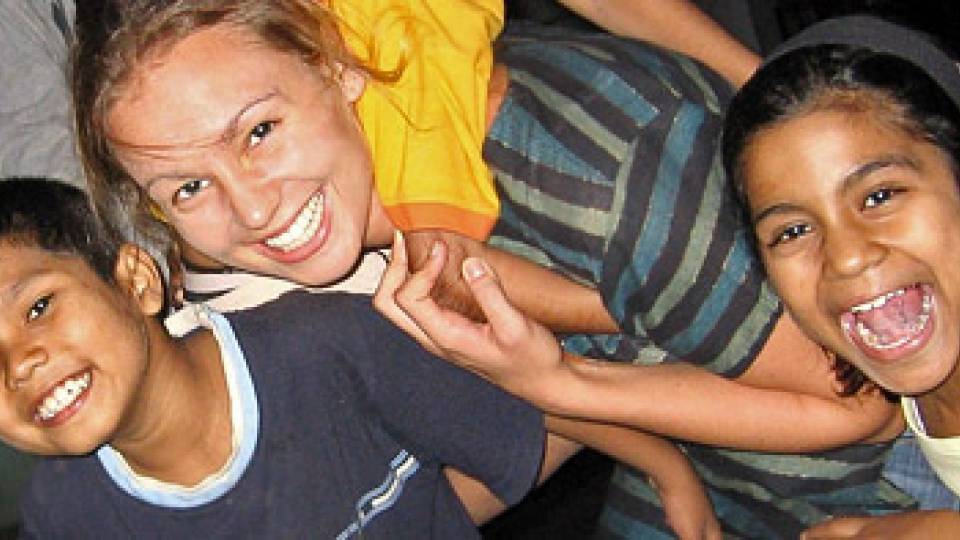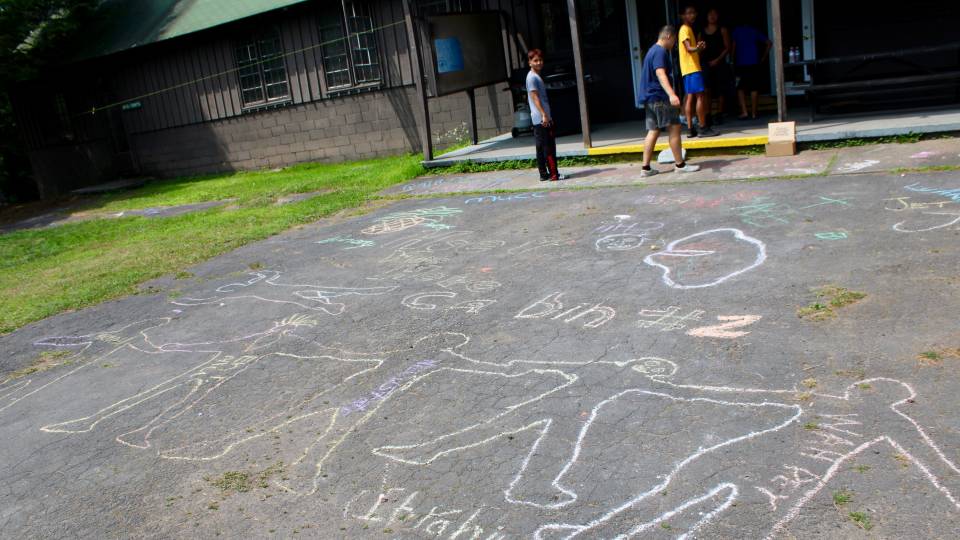In the summer of 2014, two Princeton University students learned firsthand about the struggles of Syrian refugees in Jordan. With a $10,000 grant from the Projects for Peace, Wardah Bari and Farah Amjad created a project that provided community outreach to Syrian refugees living in the Jordanian town of Zarqa.
Bari and Amjad's project was titled "Voices of the Future: Fostering Peace between Refugee and Native Communities in Jordan," and their aim was simple — to create an outlet and atmosphere where young Syrian refugees and Jordanian youth could understand each other's struggles and experiences. (The original project title was "Children's Playground," but was updated to reflect the program's mission to empower Jordanian and Syrian youth to become future leaders of their community.) Millions of people have fled their homes in Syria following the outbreak of civil war in 2011, migrating to Jordan and other Arab and European countries.
The Projects for Peace was created in 2007 by internationalist and philanthropist Kathryn W. Davis to support student initiatives in conflict resolution. The organization provides $10,000 grants for students to implement their projects in domestic and international locations. The grants are available to students at 91 U.S. universities and colleges participating in the Davis United World College Scholars Program. Princeton's participation in Projects for Peace is overseen by the Pace Center for Civic Engagement.
Bari and Amjad, members of the Class of 2016, share below their insights from their experience working with Syrian refugees.
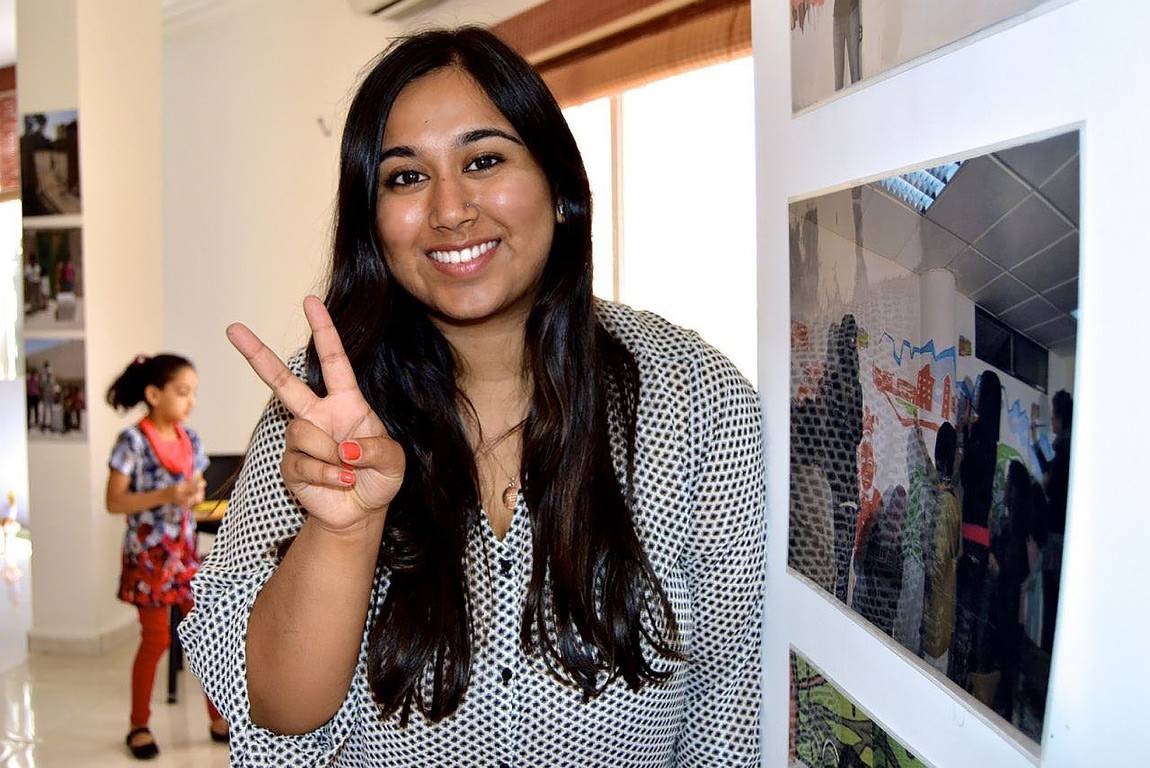
Princeton University student Wardah Bari stands near art created by young Syrian refugees and Jordanian youth as part of the project "Voices of the Future." Bari and Farah Amjad, members of the Class of 2016, received a $10,000 grant from the Projects for Peace to spend summer 2014 working with Syrian and Jordanian youth living in the Jordanian border town of Zarqa. (Photo courtesy of Wardah Bari, Class of 2016)
How did you come up with a project to help Syrian refugees?
Wardah Bari: The summer after my freshman year, I was studying Arabic in Jordan through a Princeton study abroad program. My professor got me in touch with a woman who worked at a nongovernmental organization (NGO) in a refugee camp, and she took me to Zaatari, a camp in Jordan. It was a very shocking experience for me, and when I came back on campus, Farah and I talked about my experience and we wanted to do something about it. We got in touch with the executive director of another NGO called ARDD-Legal Aid (Arab Renaissance for Democracy and Development). They provide legal services for all sorts of refugees. When we saw the opportunity through the Projects for Peace, we got really excited that we could use $10,000 to implement a project. Initially, we wanted to work in Zaatari but we knew that a lot of international attention was already there. In Zarqa, a smaller border town, there was a huge need but a very limited international presence, so we thought that would be the place where we could have the most impact.
Can you give a brief synopsis of your project?
Bari: We talked to the Pace Center about making our project unique. There are a lot of NGOs working with Syrian refugees, and we wanted to do something so that we could make a difference. We worked with ARDD, who did a preliminary survey in different locations. They looked at Syrian refugee populations and what their needs were (like learning English and math), what age groups there were and who wasn't able to receive an education.
Farah Amjad: When we were researching what we wanted to do, we found that we needed to focus on the kids. A lot of NGOs expressed the need for psychological rehabilitation and education to help kids understand their experiences. That's why we decided to focus on children. Since they were kids, we wanted to give them a space where they could let go of themselves and have fun while at the same time receive an education. We split up our curriculum into three main components: education, art, dialogue and leadership.
Bari: Syrian refugee children had a difficult time going to school in Jordan. They often couldn't attend because schools would become overcrowded and refugees would be harassed. A big portion of our project was incorporating the Jordanian community and engaging them with the Syrian refugee population.
Amjad: A lot of people approach this issue politically — making it about numbers or about giving aid — but a lot of the work we did was about community organizing. It's a huge aid component that is often overlooked. Both of us participate in the University's Religious Life Council and other dialogue and service groups on campus, so that really affected how we approached the project. We weren't going in just to work for an NGO; it was about bringing people together.
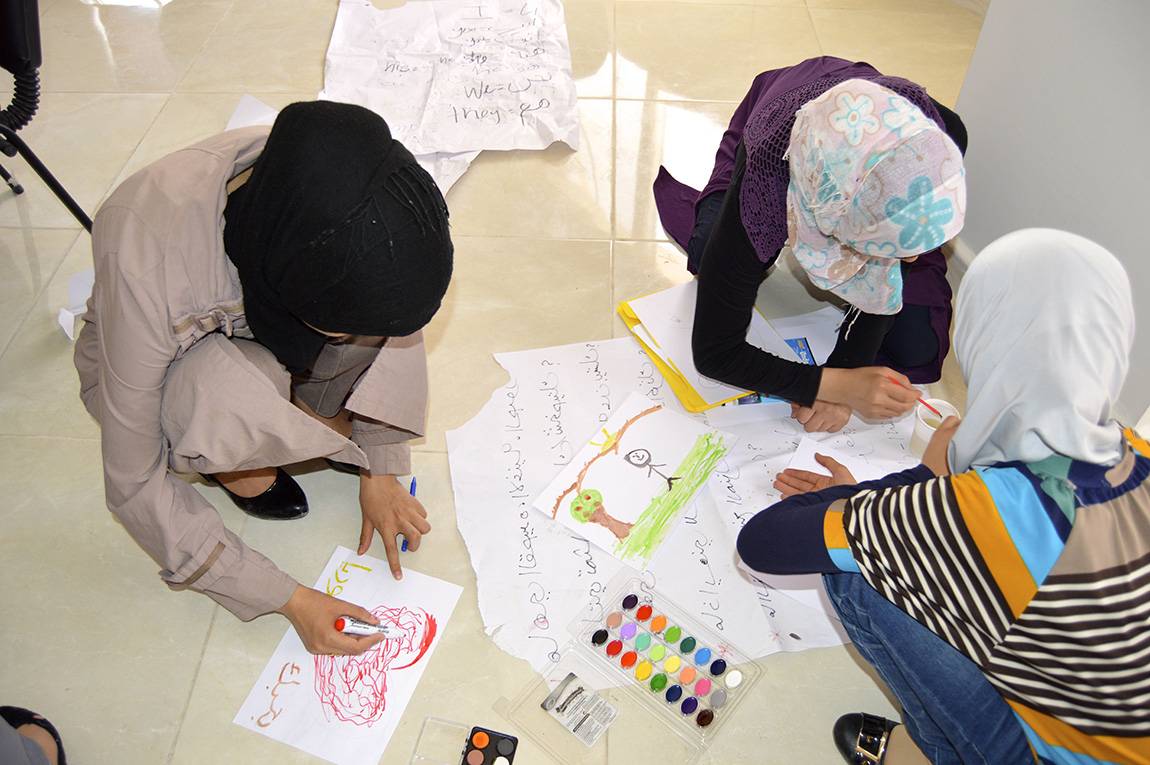
The aim of Bari and Amjad's project was to create an outlet and atmosphere where young Jordanians and Syrian refugees could understand each other's struggles and experiences through art. Here, a group of girls works on paintings, drawings and poems. (Photo courtesy of Wardah Bari, Class of 2016)
What sort of progress did you see during your program?
Amjad: Through the arts we tried to provide an outlet for the children to express themselves, their journeys and their experiences. We did a lot of creative writing and allowed kids to write in their own language. A lot of kids would end up writing about their homes back in Syria, and they would remember even little details like how their gardens were laid out. It was the first time they could really talk about their Syrian homes.
Bari: We found many of the children to be very talented, as well. One girl, Amani, was a really good writer and never knew it before. She was focused on math and science, but when she wrote, it was so beautiful. We had them write "I Am" poems that described senses — a taste, touch, memory, colors and other vivid descriptions of home. This extended to the dialogue parts of our curriculum, where we had both Syrians and Jordanians talk about their homes and struggles. While we were with the Syrian and Jordanian girls, we saw them notice similarities with each other and their struggles in Zarqa. Later on in the program, they would meet up with each other and walk to the center together as friends and for safety.
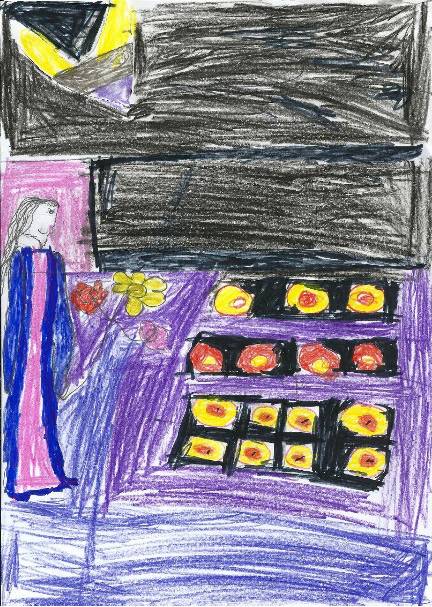
Much of the art by the Syrian refugee children participating in the "Voices of the Future" project focused on their memories of home, including this drawing. (Photo courtesy of Wardah Bari, Class of 2016)
What did you learn about the Syrian refugee crisis at the time?
Bari: This project happened in 2014, and the Syrian refugee crisis had already been occurring for nearly four years at that point. There was already a huge refugee population in Jordan, Turkey and Lebanon before the Syrian crisis, and it has grown every year since then. Refugees are going into these communities, trying to find lives for themselves because their homes in Syria were not safe. We heard unimaginable stories about homes being burned down, and families who had to flee because their political views differed from the Syrian ruling party's. People had health issues that resulted from chemical warfare or psychological damage. I don't think anyone realizes the magnitude of this problem besides the Syrian refugees themselves. They are dealing with so much, fleeing their homes and trying to find lives even though they might be separated from their families, jobless or harassed in their new communities.
Amjad: I think we just always focus on the refugees' struggle to find refuge and safety, but we forget to realize that their struggle does not end once they find refuge. They have to learn how to make a home out of their place of refuge, which is very difficult. Doing the project and seeing that people had found refuge but not the other resources they needed to shape their lives was a huge realization for me that there is more to the problem. Once you go there, you realize that people are fleeing from places like Zarqa because they can't rebuild their lives. They are trying to find new places in Europe and elsewhere because at some point, they need to move on and live their life.
Bari: A lot of people said that the war would be over eventually and they will eventually be able to go home. But the longer and longer it has gone on, people realized that maybe it won't be possible to ever go back home to Syria.
Have you been in touch with the families in Jordan with whom you worked?
Amjad: A lot of their residences were very temporary and so it was really difficult keeping in touch with them. But after that summer, our program has been sustained by our partner NGO, ARDD-Legal Aid, so the Syrian and Jordanian kids can still interact with each other.
How did your Project for Peace during summer 2014 influence you after returning to Princeton?
Amjad: We both found ways to sustain our interests and work in this issue beyond the summer through other means. The year after the program, I helped found the Muslim Advocates for Social Justice and Individual Dignity (MASJID), a student group on campus. We've continued the conversation around the refugee crisis. We had an Eid banquet in September, where students and community members came together and we raised over $7,000 to send to refugees in the Middle East. We also recently hosted a benefit concert with the Center for Jewish Life and other campus programs to raise money for refugees.
Bari: When we came back, I wanted to learn from different perspectives. Learning on the ground with the refugees was such an eye-opening experience. I wanted to learn about the role the United States is playing in responding to the Syrian refugee crisis. This past summer, I worked with the U.S. State Department Bureau of Population, Refugees, and Migration, through which I learned about refugee populations around the world. I learned more about the migration and refugee policies the U.S. has been implementing, and though there is still a lot of work to be done in helping resettle Syrian refugees (especially those with immediate medical concerns), the United States provides so much humanitarian aid through international organizations that provide resources and support for Syrians and other refugee populations around the world. The work that people are doing is really incredible, but there is always a greater need than resources available and there is always more work to be done.
Given what you learned through this project, what are your thoughts on solutions to the continued Syrian refugee crisis?
Amjad and Bari: Our work with Syrian refugees weighs heavily on our consciousness today as Western leaders and communities reconsider their commitments to resettle refugees following the terror attacks in Paris on Nov. 13. These tragic incidences of terror, which should prompt our concern regardless of where they occur, only demonstrate the need to assist refugees who have been affected by this same terror and violence for the past five years. The attacks in Paris should not detract from rightful concern and aid for the refugees.
Amjad: Everyone should think of the moral and social responsibility they might have towards the refugees. Princeton prides itself on being in the nation's service and in the service of all nations, so it needs to be in the service of the most vulnerable and right now, the refugees are the most vulnerable. Support efforts that are trying to help the refugees and take the time to become educated on the issues and look at their stories.
Bari: Definitely donate to reputable organizations. Something that a lot of people can also do is to reach out to their local representatives in Congress and really urge them to do something about this huge international issue, that we are all a part of.
